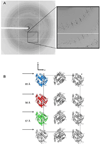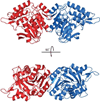Structure determination and characterization of the vitamin B6 degradative enzyme (E)-2-(acetamidomethylene)succinate hydrolase
- PMID: 20099871
- PMCID: PMC2849673
- DOI: 10.1021/bi901812p
Structure determination and characterization of the vitamin B6 degradative enzyme (E)-2-(acetamidomethylene)succinate hydrolase
Abstract
The gene identification and kinetic characterization of (E)-2-(acetamidomethylene)succinate (E-2AMS) hydrolase has recently been described. This enzyme catalyzes the final reaction in the degradation of vitamin B(6) and produces succinic semialdehyde, acetate, ammonia, and carbon dioxide from E-2AMS. The structure of E-2AMS hydrolase was determined to 2.3 A using SAD phasing. E-2AMS hydrolase is a member of the alpha/beta hydrolase superfamily and utilizes a serine/histidine/aspartic acid catalytic triad. Mutation of either the nucleophilic serine or the aspartate resulted in inactive enzyme. Mutation of an additional serine residue in the active site causes the enzyme to be unstable and is likely structurally important. The structure also provides insight into the mechanism of hydrolysis of E-2AMS and identifies several potential catalytically important residues.
Figures









Similar articles
-
How does (E)-2-(acetamidomethylene)succinate bind to its hydrolase? From the binding process to the final result.PLoS One. 2013;8(1):e53811. doi: 10.1371/journal.pone.0053811. Epub 2013 Jan 7. PLoS One. 2013. PMID: 23308285 Free PMC article.
-
PLP catabolism: identification of the 2-(Acetamidomethylene)succinate hydrolase gene in Mesorhizobium loti MAFF303099.Biochemistry. 2008 Jun 10;47(23):6233-41. doi: 10.1021/bi8004158. Epub 2008 May 14. Biochemistry. 2008. PMID: 18476725
-
The bacterial meta-cleavage hydrolase LigY belongs to the amidohydrolase superfamily, not to the α/β-hydrolase superfamily.J Biol Chem. 2017 Nov 3;292(44):18290-18302. doi: 10.1074/jbc.M117.797696. Epub 2017 Sep 20. J Biol Chem. 2017. PMID: 28935670 Free PMC article.
-
Alpha/Beta-hydrolase fold enzymes: structures, functions and mechanisms.Curr Protein Pept Sci. 2000 Sep;1(2):209-35. doi: 10.2174/1389203003381405. Curr Protein Pept Sci. 2000. PMID: 12369917 Review.
-
Structure and function analysis of Pseudomonas plant cell wall hydrolases.Prog Nucleic Acid Res Mol Biol. 1998;61:211-41. doi: 10.1016/s0079-6603(08)60828-4. Prog Nucleic Acid Res Mol Biol. 1998. PMID: 9752722 Review.
Cited by
-
How does (E)-2-(acetamidomethylene)succinate bind to its hydrolase? From the binding process to the final result.PLoS One. 2013;8(1):e53811. doi: 10.1371/journal.pone.0053811. Epub 2013 Jan 7. PLoS One. 2013. PMID: 23308285 Free PMC article.
-
Crystal Structure of StnA for the Biosynthesis of Antitumor Drug Streptonigrin Reveals a Unique Substrate Binding Mode.Sci Rep. 2017 Jan 11;7:40254. doi: 10.1038/srep40254. Sci Rep. 2017. PMID: 28074848 Free PMC article.
-
Mechanistic insights from molecular dynamic simulation of Rv0045c esterase in Mycobacterium tuberculosis.J Mol Model. 2015 Apr;21(4):90. doi: 10.1007/s00894-015-2630-4. Epub 2015 Mar 19. J Mol Model. 2015. PMID: 25783994
-
Bacterial Lactonases ZenA with Noncanonical Structural Features Hydrolyze the Mycotoxin Zearalenone.ACS Catal. 2024 Feb 16;14(5):3392-3410. doi: 10.1021/acscatal.4c00271. eCollection 2024 Mar 1. ACS Catal. 2024. PMID: 38449531 Free PMC article.
-
Effectiveness of Pyridoxal-5'-Phosphate in PNPO Deficiency: A Systematic Review.J Inherit Metab Dis. 2025 Sep;48(5):e70074. doi: 10.1002/jimd.70074. J Inherit Metab Dis. 2025. PMID: 40751583 Free PMC article.
References
-
- Eliot AC, Kirsch JF. Pyridoxal phosphate enzymes: mechanistic, structural, and evolutionary considerations. Annu. Rev. Biochem. 2004;73:383–415. - PubMed
-
- Snell EE, Haskell BE. The Metabolism of Vitamin B6, In: Comprehensive Biochemistry. Vol. 21. New York: Elsevier/North Holland; 1971.
-
- Kaneko T, Nakamura Y, Sato S, Asamizu E, Kato T, Sasamoto S, Watanabe A, Idesawa K, Ishikawa A, Kawashima K, Kimura T, Kishida Y, Kiyokawa C, Kohara M, Matsumoto M, Matsuno A, Mochizuki Y, Nakayama S, Nakazaki N, Shimpo S, Sugimoto M, Takeuchi C, Yamada M, Tabata S. Complete genome structure of the nitrogen-fixing symbiotic bacterium Mesorhizobium loti. DNA Res. 2000;7:331–338. - PubMed
-
- Yuan B, Yoshikane Y, Yokochi N, Ohnishi K, Yagi T. The nitrogen-fixing symbiotic bacterium Mesorhizobium loti has and expresses the gene encoding pyridoxine 4-oxidase involved in the degradation of vitamin B6. FEMS Microbiol. Lett. 2004;234:225–230. - PubMed
-
- Funami J, Yoshikane Y, Kobayashi H, Yokochi N, Yuan B, Iwasaki K, Ohnishi K, Yagi T. 4-Pyridoxolactonase from a symbiotic nitrogen-fixing bacterium Mesorhizobium loti: cloning, expression, and characterization. Biochim. Biophys. Acta. 2005;1753:234–239. - PubMed
Publication types
MeSH terms
Substances
Associated data
- Actions
Grants and funding
LinkOut - more resources
Full Text Sources
Molecular Biology Databases

